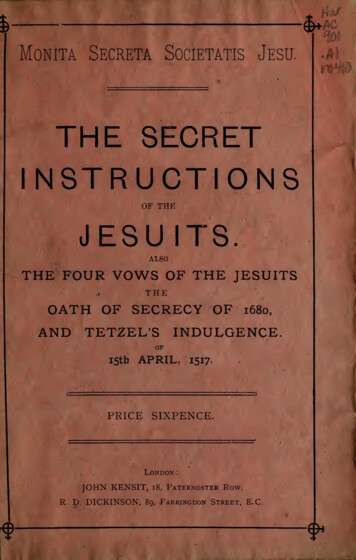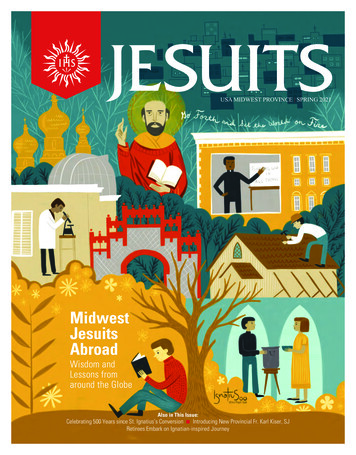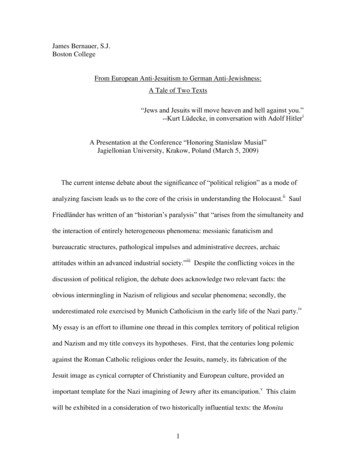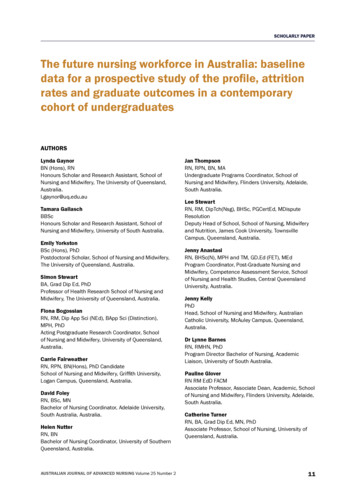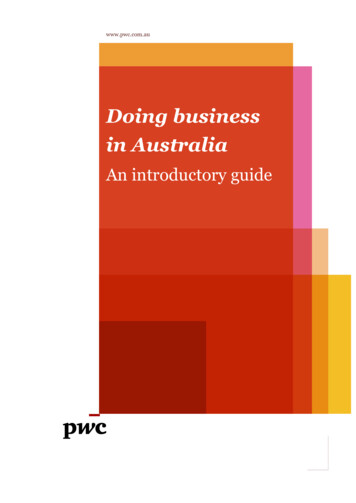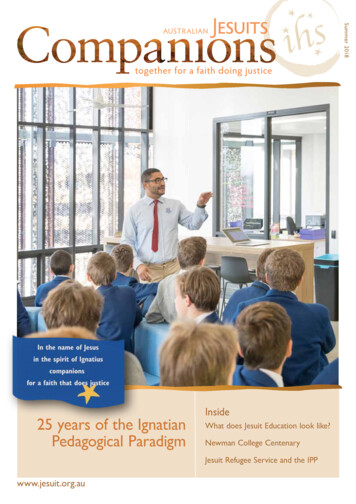
Transcription
Summer 201825 years of the IgnatianPedagogical ParadigmInsideWhat does Jesuit Education look like?Newman College CentenaryJesuit Refugee Service and the IPPwww.jesuit.org.au
PROFILEFrom the ProvincialCompanions is a publication of theAustralian Jesuits, which is producedtwice a year for friends and supportersof the Jesuit Province.Dear FriendsCONTACT Australian Jesuits20 The VaucluseRichmond Victoria 3121Telephone 03 9421 9666Some 25 years ago Peter-Hans Kolvenbach,Superior General of the Society of Jesus, gave anaddress on the topic of Ignatian pedagogy, a rich heritage ofeducational insight that can be traced back to thebeginnings of the Society.CALL TO MISSIONCOVER Science teacher Tom Bourneaddresses students at Saint Ignatius’College Riverview. As RomeroHead of House, Tom also overseesthe pastoral care of all the boys inRomero House. Through the Housesystem, Riverview ensures that everystudent has a place of safety andconnection through mentoring, rolemodelling and pastoral care.EDITOR Tim Kroenerttim.kroenert@jesuit.org.auEDITORIAL CONSULTANTSMichael McVeigh, Andrew Hamilton sj,Rob Davoren sj, Chris Horvat sj.CONTRIBUTORSMichael McVeigh, Andrew Hamilton sj,Brian McCoy sj, Chris Gleeson SJ,Deborah Kent, Anne NesbittGRAPHIC DESIGN Maggie Powermargaret.power@jesuit.org.auThe struggle of the early Jesuits, like ourstoday, was to discover a link between faith andhumanity, where belief in a God who lives inand labours for all of creation calls us to liveand labour with God and one another, and,where we can, to teach others to practise anddream the same.Hence, as Kolvenbach said, ‘Ignatianpedagogy focuses upon formation of thewhole person, heart, mind and will, not justthe intellect’, and it is where reflection anddiscernment are taught and practised.Most Ignatian educators will have their ownviews on how the five elements of Ignatianpedagogy — Context, Experience, Reflection,Action and Evaluation — are best and mostdynamically expressed. Some will emphasiseone element over others, and some willemphasise different ones at particular times.If I have a preference, it is reflection. Itis not that the other four elements are notimportant, but I believe, in this increasinglybusy and distracting world, reflection is theone we might be tempted to avoid, yet it is theone we all deeply need.The importance of reflection, such asoccurs in the daily examen, is not only toopen our hearts to seek ‘God in all things’,but to seek also in those hidden places,struggling relationships and forgottenpeople where God seems to be absent.Reflection, especially when shared withothers, can open up our human experience,bringing us out of our own small, personalworld into something larger, deeper andmore divine. We invite meaning to surfaceout of human experience.Ignatian pedagogy invites us to believe inChristian humanism, forging a bridge thatlinks our faith in God with the experienceof God’s love and presence in ourselvesand in all of creation. It invites us to carveout an inner reflective space in our lives, toallow that experience to enrich our worldand our part in it.Fr Brian F. McCoy SJ, Provincial 2018 Jesuit CommunicationsPrinted on environmentally responsiblepaper made with fibre sourced fromcertified plantation forestsAbovet: Ignatius Sterling Hundley. Courtesy Loyola Press.2Companions Summer 2018
Province NewsBook reviewBill Uren SJ, With(Great) Respect:Forty Homilies,Newman College,ISBN 9780646982021.100 YEARS OF NEWMAN COLLEGESaturday 25 March 2018, the Vigil of PalmSunday, marked exactly 100 years sincethe official opening of Newman College.To celebrate, Dr Val Noone, fellow ofthe School of Historical and PhilosophicalStudies at the University of Melbourne,launched Contesting Catholic Identity:The Foundation of Newman College,Melbourne 1914-18, by Michael Francis,the assistant dean of studies at Newman.The book, which catalogues eventsleading up to the collegeopening and beyond,constituted a very appropriatebeginning to centenarycelebrations, which havecontinued throughoutthe year.The official college historyby Brenda Niall, FrancesO’Neill and Jo Dunin waslaunched by the universitychancellor and formercollegian, Allan Myers QC,AC, at the Cardinal NewmanDinner on 6 April, attendedby around 250 people.The centenary year hasalso seen the publicationof a collection of homiliesby Rector Fr Bill Uren SJ(see review inset), and of Walter BurleyGriffin: The Architecture of NewmanCollege, 1915‑18, by Dr Jeffrey Turnbull.A new book of poems by the lateFr Peter Steele SJ is forthcoming.A few days after the launch of theofficial history, more than 200 formercollegians and their partners returnedto the college for Mass, lunch and aconcert on 14 and 15 April. The choirsang at the Mass and then gave a concertthat featured the music of Edward Elgar,Eric Whitacre, SamuelBarber, Henry Mancini,Richard Rogers and BartHoward.The choir, too, hasproduced a centenary CD,which is now available.Frances O’Neill arrangedan extensive archival displayin the Oratory, and twofurther lunches are plannedfor November this year.Newman Old CollegiansAssociation held a dinnerdance in late May, wherenearly 450 former collegiansand their partners werepresent. In July, a lunch washeld for current and formerstaff and Jesuits.These homilieswere preached toa congregation ofuniversity students at Newman College.They put Gospel stories into context,developing in an attractive way theircomplexity and richness, and relatingthem freshly to the world of thelisteners.Fr Uren often turns to prominentissues of the day, such as same-sexmarriage and the clerical sexual abuseof children. He does not force hisargument on his hearers but leavesthem well informed on the issues, freeto reflect on them and to draw theirown conclusions.The language is easy, thecommunication direct, and the demandsof the Gospel made attractive to mindand heart. The breadth of the preachingevokes a similarly broad reception inthe hearer’s imagination.Proceeds from the four celebratorylunches will be directed to JesuitMission, Jesuit Refugee Service,Jesuit Social Services, and threeinstitutions with significant links toformer collegians:Peace and Diversity Australia;The School of St Jude in Tanzania; andThe Opening the Doors Foundation.Pictured: (top left) Celebratory lunch atNewman College.Companions Summer 20183
JESUIT EDUCATIONWhat does Jesuit education look like?The Ignatian Pedagogical Paradigm is most effectively used as a whole school approach rather than just a classroom tool,writes Fr Chris Gleeson SJ.In April 1993 I had the good fortuneto be working in Rome in the officeof the Society of Jesus’ EducationSecretary, Fr Vin Duminuco SJ, beforemy taking up the role of headmaster atSt Ignatius’ College Riverview.Indeed, I was present at the launch ofthe Ignatian Pedagogical Paradigm (IPP)by Fr General Peter-Hans Kolvenbach SJ,at an international workshop at VillaCavalletti on 29 April 1993.One might argue that the IPP has beenanother stage in the process of renewingand refreshing Jesuit education since 1599,when the final draft of the Ratio Studiorumor ‘Plan of Studies’ was published.The Ratio was a successful attemptto systematise Jesuit schooling that lasted174 years until the Suppression of theSociety in 1773.In 1986, 400 years after the firstdraft of the Ratio, an internationalgroup of Jesuit educators producedThe Characteristics of Jesuit Education asa contemporary identity statement. Inhis introduction to this fine publication,Fr General Kolvenbach wrote:‘A document listing the characteristicsof Jesuit education is not a new RatioStudiorum. However, like the Ratio andas a continuation of the tradition begunthen, it can give us a common vision anda common sense of purpose; it can bea standard against which we measureourselves.’‘4 it can give us a common vision and a common senseof purpose.’Companions Summer 2018Pictured: Delegates to the Villa Cavalletti workshop included three Australian Jesuits: Fr DavenDay (East Asia Jesuit Conference President at the time) (front row, third from left), Fr Bob Slatteryfrom Hazaribag Mission (third-back row, second from left), and Fr Chris Gleeson SJ (third row,fourth from left). Fr General Kolvenbach is also pictured (front row, fifth from left).While people reported satisfaction withthe Characteristics as a visionary statement,teachers and administrators around theglobe were soon asking for practical helpto embed them in everyday practices.The International Commission on theApostolate of Jesuit Education (ICAJE)in 1993 responded by endeavouring todemonstrate that the constant interplay ofexperience, reflection and action integralto Ignatius’ Spiritual Exercises is essentialto the teaching-learning process.To this tripartite cycle were added thetwo bookends of context and evaluation,to complete the paradigm in five parts, aswe know it today.In their effort to make theCharacteristics more accessible andpracticable in the classroom, ICAJEpublished Ignatian Pedagogy: A PracticalApproach — a valuable discussion andelaboration of the IPP explicitly linked tothe Spiritual Exercises.In my experience of school visits andtalking to teachers and administrators, Ibelieve the IPP has been most successfulwhere teachers already have a goodunderstanding of Ignatian spirituality.If the IPP has been used only to deviselesson plans, or merely as an instrumentto help students, it has been deficient.It is crucial to understand that theIPP is also about the spirituality ofthe teacher.In speaking to teachers about the IPP,I always begin with the following idea ofFr Richard Rohr OFM in Things Hidden:Scripture as Spirituality: ‘You lead othersto the depth to which you have beenled . you can only transform people tothe degree you have been transformed.’Elsewhere, Rohr writes challenginglythat education is about transformation.What we don’t transform in ourselves,we transmit. In short, the depth ofone’s spirituality as a teacher is pivotal
Far Left: Title page of the firstedition of Ratio Studiorum(1586) Georgetown University.(Left) Students from St Ignatius’College Geelong.Title page of the first edition of the Ratio studiorum (1586).to the effectiveness of one’s teachingministry and the success of the IPP.Fr Ron Rolheiser expresses this wellin Seeking Spirituality: ‘Long before wedo anything explicitly religious at all,we have to do something about thefire that burns within us. What we dowith the fire, how we channel it, isour spirituality.’A teacher or administrator withoutsome Ignatian fire in the belly, or unableto channel that fire, is not going tobe a successful exponent of the IPP inthe classroom, or any other space forthat matter.There is some support for thisargument in Dr Chris Hayes’ 2006doctoral thesis on the influence of theIPP in Australian Jesuit schools. Afterresearching teachers’ perceptions ofthe IPP in an admittedly small sample ofschools, Dr Hayes recommended:‘Jesuit authorities need to providemore opportunities for spiritualformation of lay teachers before theirintroduction to Ignatian pedagogy. If theywish to foster the Jesuit charism andspirituality in their schools, a morelogical place to start is an introductionto the experience of Ignatian spiritualityfor teachers.’Interestingly, he also recommendsthat the IPP be used more effectivelyas a ‘whole school’ approach toprocessing issues rather than berestricted just to classroom applications.Administrators could take the lead anddevelop pastoral care policies usingthe pedagogy.In conclusion, our previous FrGeneral, Adolfo Nicolás SJ, was fond ofasking: ‘Is this a new school or an oldschool in a new building?’He saw a ‘new’ school as one thattakes student-centred learning andaccompaniment by the teacher asessential. No longer do we focus on theteacher as the sage on the stage, but asthe guide at the side. Our students arenot in front of us any more; they arealongside us.At Riverview in January 2012,Fr Nicolás stressed the importance ofaccompaniment with the words: ‘Youngpeople have very good hearing in thewater, but not on dry land.’Despite the difficulties ofimplementing the IPP in Jesuit schoolsaround the world over the past25 years, its value remains in connectingthe heart and soul of Ignatian spiritualitywith pedagogical practice.It has made a good contributionto addressing the challenge extendedto educators by Pope Francis: Inaccompanying young people today, ‘weneed a new language, a new way of sayingthings. Today, God asks this of us: toleave the nest which encloses us in orderto be sent.’‘ we need a new language,a new way of saying things.Pope FrancisCompanions Summer 2018’5
SCHOOLSIPP is more than a tool for studentsThe Ignatian Pedagogical Paradigm (IPP) is not just for students. Jennie Hickey,Executive Officer of Jesuit Education Australia, says one of its distinguishingfeatures is that it’s a tool ‘that teachers can use to reflect on who they are’.‘When they walk into a classroom theycan ask: What’s my context? What’s myexperience of the subject I am teaching?How did I make sense of what it is that Iam teaching, and how does this bring mecloser to God?’Many staff across Jesuit andCompanion Schools could surely relate.Sharon McClean, Professional Reviewand Development Companion at StIgnatius’ College Riverview, recalls thatin her early teaching career she was ‘taskorientated’, but says ‘Ignatian pedagogyhas changed the way I look at teachingand learning’.Rather than covering the curriculum,she says, her approach now is moreabout uncovering it, ‘asking what I want6Companions Summer 2018the students to know about their world,bringing them to ask questions and to havea sense of wonder about the world theylive in.‘I have felt it important to linkcurriculum to awareness of the difficultiesfaced by refugees and First Nationspeople’, she adds, ‘and the role we havein environmental and urban stewardship.Curriculum has become a vehicle toprovide opportunities for reflection,action and evaluation.’Joe El-Khoury, Head of the JuniorSchool at St Aloysius’ College MilsonsPoint, notes that the IPP is a ‘practicalteaching framework that applies to allsubject areas and students of all ages andbackgrounds’.‘It fosters in our students the abilityto be critical thinkers, to be creative, tohave that sense of discovery about whatthey’re learning on a daily basis’, he says.‘But ultimately it helps them to be lifelonglearners and people for others.’Cathy Larkin, Principal of Loyola SeniorHigh School, Mt Druitt, describes the IPPas ‘the lens through which I work’ and‘the test of who I am in the midst of thatwork’.She relates the ways in which eachof the five components of the paradigm— context, experience, reflection, actionand evaluation — shapes the ways sheapproaches her work and her workingrelationships on a daily basis.‘In working with my teachers andstaff’, she says, ‘it’s imperative I knowtheir context; understand their needs .know their story and accompany them,and really live that apostleship of listening,which is part of our Ignatian legacy.
Pictured: Ignatianpedagogy in action at(clockwise from far left)Xavier CollegeMelbourne, LoyolaSenior High School MtDruitt, and St Ignatius’College Geelong.‘When it comes to experience, I askhow does each member of our communitycontribute to Ignatian identity and mission?. it’s important that I model and practisediscernment, and enable opportunities forour staff to do that as well.‘Which brings me to reflection, becausetrue discernment can only be born ofreflection. To that end we pray the examenevery time the staff gather, and at everystaff meeting we have ten minutes setaside for staff to journal.‘Action I see as experience born ofreflection. I think very much of the magishere, that this is now our experience livedin both our inner and outer life at muchgreater depth and experience.‘When I come to evaluation, I’mconstantly assessing and growing inawareness as to the extent to which thistruly is our way of proceeding. Throughfeedback from various sources I believethat it is, and that is of course my hope.’Kieran Prowse, Head of Mannix Houseat Loyola College in Watsonia, Vic., saysthe IPP is a ‘wonderful, incredibly practicaltool’, and recalls it being of great benefitduring a wellbeing conference for Jesuitand Companion Schools.‘In that context, wellbeing leaderswere able to share great insight intoideas of best practice, talking abouttheir experience, reflecting on ideas andprograms that have been shared in theschools’, he says.Subsequently, they were able to resolve‘to take great action when they go back totheir schools, and evaluate that action inthe interests of best practice of studentsin the area of wellbeing’.‘The greatest thing the IPP has givenus as Ignatian educators’, says MelindaRoberts, Head of Teaching and Learning atXavier College Melbourne, ‘is the abilityto embed and infuse the attributes of thecontemplative in action.’This, she says, ‘includes the critical skillto be able to acknowledge and honourdifferent personal or cultural contexts;to then demonstrate this knowledgeby the authentic experience of it, thusenabling reflection, which I believe isthe most fundamental dimension of anIgnatian education.‘The IPP has enabled us to becomebetter teachers, better students andtherefore better human beings bycontemplating the importance of aholistic education that exists beyond theclassroom and resides in ones own heart.’Samantha Boreham says that in theclassrooms of the Trade Training Centreat Loyola Senior High School, Mt Druitt— of which she is Deputy Principal — theIPP is used every day.‘Our students are able to take thelearnings from their workplace into theclassrooms’, she says, ‘and we use theparadigm in order for them to understandthe context that they receive at theworkplace, and apply it to their learning,so that they may reflect on who they areand what they want from life.’‘Our present students will, in time,assume various roles . in government,in the administration of justice, others inall sorts of responsible occupations’, StIgnatius of Loyola said of the importanceof education.‘The children of today will becomethe adults of tomorrow, so their goodformation in life will benefit many others .to the greater glory of God.’It is encouraging to see this workof formation, through the IgnatianPedagogical Paradigm, taking place inthe lives of both the students and theteachers and staff of our Jesuit andCompanion Schools.Companions Summer 20187
INTERNATIONALInternationalDreaming of an Ignatian schoolAt the moment, it’s still just an empty 62-acre block in Drury, south ofAuckland. But for a group of locals, this piece of land represents a dream morethan 20 years in the making, writes Michael McVeigh.John Mills remembers, ‘It started in September 1997, with Catholic men in thedistrict getting together and deciding that a secondary school was required —that we had the numbers.’A committee was formed with thepurpose of establishing which religiousorder would be aligned with the college.‘After much study, we decided theSociety of Jesus was the best, so let’s gofor the best’, says John.Fr Chris Gleeson SJ, who was theheadmaster at St Ignatius’ CollegeRiverview at the time, remembers thecommittee visiting the school in 1998to discuss the proposed school with theAustralian Jesuit Province.‘It looked like an All Blacks rugbyscrum coming into my office’, heremembers.Thus began a relationship that hasspanned more than 20 years and fourProvincials, and while the school has yet8Companions Summer 2018to break ground, the dream continues forthe construction of what will be known asSt Ignatius of Loyola College.‘They are amazingly committedpeople’, says Fr Gleeson. ‘I have greatadmiration for them to be sticking withthis, when their own children have lefthome to study and start working.’‘We’re very hopeful in future that we’ll get thecollege underway. It’s beena mammoth exercise, butthere’s a lot of determinationwithin the committee.’Overcoming hurdlesThe land for the new school waspurchased by Auckland Bishop Pat Dunnin 2000.‘It’s a magnificent piece of land. It wouldhave maybe a kilometre or more of themain railway line, and there is a proposedstation there was well’, says Mr Mills.The first struggle came over the use ofthe land.‘We had people objecting to it’, saysMr Mills. ‘Under Bishop Pat’s guidance, thediocese challenged in the District Court,Environmental Court and the High Court.’They won that case, but that wasjust the first hurdle. Under the CatholicIntegrated Act (1975), Catholic schools inNew Zealand are integrated into the statesystem. What that means, says Mr Mills, isthat while the Church owns the land, thegovernment needs to supply finance forthe buildings and the running of the school.They were close to a deal, but lastyear’s change in government meant thatthey needed to start the process all overagain. ‘The diocese is working with thegovernment and the Ministry of Education
CEL E B R AT I N G25yearsCELEBRATINGA RICHAND DIVERSE COMMUNITYAnother Jesuit CompanionSchool this year celebratedits 25th anniversary —Loyola Senior High School inMt Druitt, NSW.Pictured: The proposed site andsurrounds for St Ignatius of LoyolaCollege Drury.to get it over the line’, says Mr Mills.The case for the school was a solidone 20 years ago, and with the expandingpopulation it’s even more necessary today.At the moment there are around 1000students travelling two to three hourseach day from the south of Auckland toCatholic schools in the city.‘It’ll be a college of at least 1000 pupils,that’s how big the demand is out here’,says Mr Mills. ‘They’ll fill it straight away.’A trans-Tasman relationshipWhile the Jesuits have no institutionalpresence in New Zealand, a numberof men have joined the Society fromthere, including current Jesuits Fr AntonyCampbell, Fr Richard Shortall, Fr MichaelSmith, Fr Rob Morris and Fr Justin Glyn.Fr Shortall is currently offering spiritualdirection to priests and lay people in theHamilton Diocese. The Jesuits also havea history of working in seminaries anduniversity chaplaincies in the country.A number of Jesuits have supportedthe proposed new school over the yearsalong with Fr Gleeson, including Fr GerryHealy, Fr Ross Jones and Fr Jack McLain.Committee members have been part ofProvince events for many years, attendingProvince Gatherings and making regulartrips across the Tasman. Jesuits also visitedNew Zealand to bless the site for theschool and meet some key players in thediocesan and Catholic education offices.‘The Steering Committee is verygrateful to the Society of Jesus for itscommitment to the college’, says Mr Mills.The plan is for St Ignatius of LoyolaCollege to be an Ignatian CompanionSchool, and while it will come under theumbrella of the diocese, it will be closelyaligned with Ignatian pedagogy.But at the moment, the school existsonly in people’s imaginations. What’sneeded to make it real are prayers andfunding.‘We’re very hopeful in future thatwe’ll get the college underway. It’s beena mammoth exercise, but there’s a lotof determination within the committee’,says Mr Mills.The school’s founding Jesuit principal,Fr Ross Jones SJ, his successor,Fr Brendan Kelly SJ, and two formerschool chaplains, Fr Tom RenshawSJ and Fr Iain Radvan SJ, joined thecommunity for the Mass and celebrationon Sunday 26 August.Fr Jones spoke at the opening aboutthe founding of the school, and theincredible multicultural mix of studentsthat has enriched the community tothis very day.‘We began with about 160 year 11students’, he said. ‘There were so manynational backgrounds. Such a richness.When I asked students about thebirthplace of grandparents, I estimatedthere were some 50-plus countriesof origin .‘The vibrant tapestry of our culturalmix was something we celebrated fromthe earliest days. We had two flagpolesand on any national day, we flew, whenwe could, the flag of that country nextto our national flag.‘This sense of heritage andcommunity led us to celebrate ourpatron’s day, St Ignatius’ Day, within amulticultural day. A Mass (with prayersin different languages), foods fromso many ethnic and cultural sources,complemented by song and dance insuch a range of languages and styles.It is wonderful to see that traditioncontinues.’Companions Summer 20189
JESUIT REFUGEE SERVICERefugee voices transform Catholic studentsA group of boys crowd around Simon as he finishes his story. The horrific details of the war in Syria that resulted inSimon’s journey to Australia have piqued their interest. Students often experience a personal connection to Simon andfeel compelled to talk to him.Another speaker tells of beingawakened in the middle of thenight as a 10-year-old. Her parentsdressed her in several layers of clothes,put her into a taxi, and told her theywere going on holiday. The ‘holiday’included a seven-day walk throughthe snowy mountains from Iran intoIraq, eating only raisins for sustenance.To this day, she cannot eat raisins.These are but two of many speakerswith extraordinary life experiences whovisit Sydney-based schools as part ofJesuit Refugee Service’s Refugee Voicesprogram. Each story is unique, but all ofthe speakers show amazing resilience,perseverance and courage.In 2018, JRS has partnered with15 schools to run the Refugee Voicesprogram. Catholic Education Diocese ofParramatta has also worked closely withJRS to build capacity among its staff onissues of people seeking asylum.Based on storytelling, the programaims to raise awareness of issuessurrounding people seeking asylum andrefugees, particularly those that JRSaccompanies, serves, and advocates forhere in Australia.The opportunity to hear a person withlived experience describe their previouslife and the need to seek protection frompersecution is powerful.Using elements of the IgnatianPedagogical Paradigm, the challenge isto empower students to reflect furtheron and engage with the issues and takeaction to question the injustices of thepresent system.Confronted by the lived experiencesof these speakers, students are madeto question their preconceptions, andlearning becomes transformative.10Companions Summer 2018While each presentation is tailoredto a theme nominated by the school, allbegin with a JRS representative explainingthe current global situation for refugees,utilising visuals and UNHCR statisticaldata. It is critical for students to clearlyunderstand Australia’s complicatedrefugee and asylum policies, and toacknowledge the impact of our responseto the current world situation.Opportunities for further action aresuggested and provided to students andthe school community, such as writing toMPs or organising events. This enablesthe students to consider their role inAustralian society and how they canmove beyond knowledge to action.Anne Nesbitt is Project Officer,Bookends Project and SchoolsEngagement Coordinator, JesuitRefugee Service Australia. For moreinformation about Jesuit RefugeeService’s work with schools visit theProvince website, jesuit.org.auPictured: (from top) Xavier College Llandilostudents Tom and Holly with Simon Shahin(speaker) and Anne Nesbitt (JRS); Formerrefugees Milad Kader (left) and ElizabethKoudakpo (second from right) with year 7students at St Patrick’s Marist College,Dundas; Speaker Deena with students at OurLady of Lourdes Primary School.
HIGHER EDUCATIONStruggling with the big questions at Jesuit College of SpiritualityFr General Arturo Sosa SJ, at the recent gathering of the International Association of Jesuit Universities in Spain, reminded us:‘The growing commitment of the Society of Jesus within the university’s endeavour takes on its meaning through the desire toeffectively contribute to enabling a dignified, full life for each and every human being, both in the present and in the future.’At Jesuit College of Spirituality (JCS), we aim to establish a community ofacademics, students and professional partners dedicated to the pursuitof a deep understanding of the interconnection between personal formationand organisational development within an Ignatian framework to empowercommunity leadership.In higher education, as at all levelsof Jesuit education, consistent use ofthe Ignatian Pedagogical Paradigm isfundamental to the teaching-learningprocess. This requires both faculty andstudents to engage in critical reflectionthroughout the learning process.At JCS, the only specialist Collegeof the University of Divinity, the focusis on context, experience, action andevaluation towards holistic formationof women and men for others so thatall may live full lives. Fr General says:‘Living fully means plunging into thebroad range of skins and cultures thatmake up humanity. It involves delvinginto the historical and social processescurrently underway.’A central component of the Ignatianpedagogical model is self-awarenessthrough reflection, which guides thelearner to a deep engagement with theircultural reality, leading to transformationof self and others. It begins inexperience, moving to reflectionthrough the posing of critical questions,always with the goal of improved futureengagement and care of self and others.JCS faculty guide the reflection inclass sessions and tutorials, and bycarefully constructed assessment tasks.We engage academic staff who arecompetent in teaching the skill of selfreflection, which facilitates personalgrowth within a student-centredcurriculum framework. Students areexpected to apply this reflection in theirministerial practice.As our educational goal is to developmen and women who are competent,compassionate and willing to engagewith their communities, our facultypractise ongoing curriculum revision, thefruit of their reflection and evaluation ofthe learning process in all units.The focus of this critical reflectionis context, experience, actionand evaluation.How does the student’s contextand experience affect their learning?How can their learning be applied? Theindividual’s professional and personaltransformation i
dance in late May, where nearly 450 former collegians and their partners were present. In July, a lunch was held for current and former staff and Jesuits. Bill Uren SJ, With (Great) Respect: Forty Homilies, Newman College, ISBN 9780646982021. These homilies were preached to a congregation of university students at Newman College.

